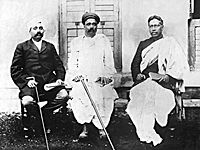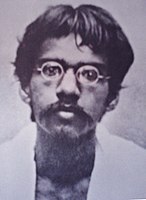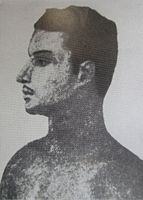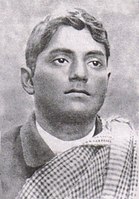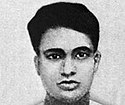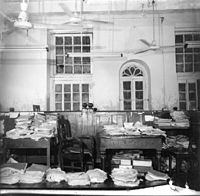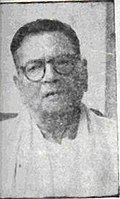Revolutionary movement for Indian independence
This article has multiple issues. Please help improve it or discuss these issues on the talk page. (Learn how and when to remove these template messages)
|
The Revolutionary movement for Indian Independence was the part of the Indian independence movement comprising the actions of violent underground revolutionary factions. Rash Behari Bose was called'father of Indian revolutionary movement'.Groups believing in armed revolution against the ruling British fall into this category, as opposed to the generally peaceful civil disobedience movement spearheaded by Mohandas Karamchand Gandhi. The revolutionary groups were mainly concentrated in Bengal, Maharashtra, Bihar, the United Provinces and Punjab. More groups were scattered across India.
Beginnings[edit | edit source]
Apart from a few stray incidents, the armed rebellion against the British rulers was not organised before the beginning of the 20th century. The revolutionary philosophies and movement made its presence felt during 1905 partition of Bengal. Arguably, the initial steps to organise the revolutionaries were taken by Aurobindo Ghosh, his brother Barin Ghosh, Bhupendranath Datta, Lal Bal Pal and Subodh Chandra Mullick, when they formed the Jugantar party in April 1906.[1] Jugantar was created as an inner circle of the Anushilan Samiti, which was already present in Bengal, mainly as a fitness club.
Lala Lajpat Rai of Punjab, Bal Gangadhar Tilak of Bombay, and Bipin Chandra Pal of Bengal, the triumvirate were popularly known as Lal Bal Pal, changed the political discourse of the Indian independence movement.
Aurobindo Ghose was one of the founding member of Jugantar, as well as being involved with nationalist politics in the Indian National Congress and the nascent revolutionary movement in Bengal with the Anushilan Samiti.
Barindra Kumar Ghosh, was one of the founding members of Jugantar and younger brother of Sri Aurobindo.
Bhupendranath Datta, was an Indian revolutionary who was privy to the Indo-German Conspiracy.
Andhra Pradesh[edit | edit source]
Uyyalawada Narasimha Reddy (died 22 February 1847) was the son of a former Indian Telugu polygar who was at the heart of a rebellion in 1846, when 5000 peasants rose up against the British East India Company (EIC) in Kurnool district, Rayalaseema Region of Andhra Pradesh. They were protesting changes to the traditional agrarian system the British introduced in the first half of the nineteenth century to the traditional agrarian system. Those changes, which included the introduction of the ryotwari system and other attempts to maximize revenue, impacted lower-status cultivators by depleting their crops and leaving them impoverished.
Bengal[edit | edit source]
Anushilan Samiti[edit | edit source]
Established by Pramathanath Mitra, it became one of the most organised revolutionary associations, especially in eastern Bengal, where the Dhaka Anushilan Samiti had several branches and carried out major activities.[2] Jugantar was initially formed by an inner circle of the Kolkata Anushilan Samiti, like the Palmach of Haganah. In the 1920s, the Kolkata faction supported Gandhi in the Non-Cooperation Movement and many of the leaders held high posts in Congress. The Anushilan Samati had over five hundred branches. Indians living in America and Canada had established the Gadar Party.
Jugantar[edit | edit source]
Khudiram Bose was one of the youngest Indian revolutionaries tried and executed by the British.
Prafulla Chaki, was associated with the Jugantar. He carried out assassinations against British colonial officials in an attempt to secure Indian independence.
Jatindranath Mukherjee (Bagha Jatin) in 1910; was the principal leader of the Jugantar Party that was the central association of revolutionary Indian freedom fighters in Bengal.
Barin Ghosh was the main leader. Along with 21 revolutionaries including Bagha Jatin, he started to collect arms and explosives and manufactured bombs. The headquarters of Jugantar was located at 93/a Bowbazar Street, Kolkata.
Some senior members of the group were sent abroad for political and military training. One of them, Hemchandra Kanungo, obtained his training in Paris. After returning to Kolkata he set up a combined religious school and bomb factory at a garden house in the Maniktala suburb of Calcutta. However, the attempted murder of district Judge Kingsford of Muzaffarpur by Khudiram Bose and Prafulla Chaki on 30 April 1908 initiated a police investigation that led to the arrest of many of the revolutionaries.
Bagha Jatin was one of the top leaders in Jugantar. He was arrested, along with several other leaders, in connection with the Howrah-Sibpur Conspiracy case. They were tried for treason, the charge being that they had incited various regiments of the army against the ruler.[3]
Jugantar, along with other revolutionary groups, and aided by Indians abroad, planned an armed revolt against the British rulers during the First World War. This plan largely depended on the clandestine landing of German arms and ammunitions in the Indian coast.[4][5] This plan came to be known as the Indo-German Plot. However, the planned revolt did not materialise.
After the First World War Jugantar supported Gandhi in the Non-Cooperation Movement and many of their leaders were in the Congress. Still, the group continued its revolutionary activities, a notable event being the Chittagong armoury raid.
Benoy Basu, Badal Gupta and Dinesh Gupta, who are noted for launching an attack on the Secretariat Building – the Writers' Building in the Dalhousie square in Kolkata, were Jugantar members.
Uttar Pradesh[edit | edit source]
Hindustan Socialist Republican Association[edit | edit source]
The Hindustan Republican Association (HRA) was established in October 1924 in Kanpur, Uttar Pradesh by revolutionaries like Ramprasad Bismil, Jogesh Chatterjee, Chandrashekhar Azad, Yogendra Shukla and Sachindranath Sanyal.[6] The aim of the party was to organise armed revolution to end the colonial rule and establish a Federal Republic of the United States of India. The Kakori train robbery was a notable act of this group. The Kakori case led to the hanging of Ashfaqullah Khan, Ramprasad Bismil, Roshan Singh, Rajendra Lahiri. The Kakori case was a major setback for the group. However, the group was soon reorganised under the leadership of Chandrashekhar Azad and with members like Bhagat Singh, Bhagwati Charan Vohra and Sukhdev on 8 and 9 September 1928– and the group was now christened Hindustan Socialist Republican Association (HSRA).
In Lahore on 17 December 1928, Bhagat Singh, Azad and Rajguru assassinated Saunders, a police official involved in deadly lathi-charge on Lala Lajpat Rai. Bhagat Singh and Batukeshwar Dutt threw a bomb inside the Central Legislative Assembly. The Assembly Bomb Case trial followed. Bhagat Singh, Sukhdev Thapar and Shivaram Rajguru were hanged on 23 March 1931. Lua error in Module:Gallery at line 124: attempt to call field '_warning' (a nil value).
Maharashtra[edit | edit source]
[edit | edit source]
The Abhinav Bharat Society (Young India Society) was a secret society founded by Vinayak Damodar Savarkar and his brother Ganesh Damodar Savarkar in 1904.[8] Initially founded at Nasik as "Mitra Mela" when Vinayak Savarkar was still a student of Fergusson College at Pune, the society grew to include several hundred revolutionaries and political activists with branches in various parts of India, extending to London after Savarkar went to study law. It carried out a few assassinations of British officials, after which the Savarkar brothers were convicted and imprisoned. The society was formally disbanded in 1952.[9][10]
Savarkar's revolutionary propaganda led to the assassination of Lt. Col. William Curzon-Wyllie, the political aide-de-camp to the Secretary of State for India, by Madanlal Dhingra on the evening of 1 July 1909, at a meeting of Indian students in the Imperial Institute in London. Dhingra was arrested and later tried and executed. A. M. T. Jackson, the district magistrate of Nasik, was assassinated in India by Anant Laxman Kanhare in 1909 in the historic "Nasik Conspiracy Case".[11][12]
The investigation into the Jackson assassination revealed the existence of the Abhinav Bharat Society and the role of the Savarkar brothers in leading it. Vinayak Savarkar was found to have dispatched twenty Browning pistols to India, one of which was used in the Jackson assassination. He was charged in the Jackson murder and sentenced to "transportation" for life. Savarkar was imprisoned in the Cellular Jail in the Andaman Islands in 1910.[11]
Kotwal Dasta[edit | edit source]
Veer Bhai Kotwal alias Veer Bhai Kotwal during Quit India Movement formed group of underground mercenaries called "Kotwal Dasta", a parallel government in the Karjat taluka of Thane district. They were about 50 in numbers including farmers and voluntary school teachers. They decided to cut down the electric pylons supplying electricity to Mumbai city. From September 1942 through November 1942 they felled 11 pylons, paralyzing the industries and railways.
South India[edit | edit source]
The uprising against the British was evidenced at Halagali (Mudhol taluk of Bagalkot district). The prince of Mudhol, Ghorpade, had accepted British overlordship. But the Bedas (hunters), a martial community, were seething with dissatisfaction under the new dispensation. The British proclaimed the Disarming Act of 1857 whereby men possessing firearms had to register them and secure a license before 10 November 1857. Babaji Nimbalkar, a soldier thrown out of job from Satara Court, had advised these people not to lose their hereditary right to own arms.
One of the leaders of the Bedas, Jadgia, was invited by the administrator at Mudhol and was persuaded to secure a license on 11 November, though Jadgia had not asked for it. The administrator's expectation that others would follow Jadgia was belied. So he sent his agents to Halagali on 15 and 20 November and again on 21. But the entreaties of the agents did not succeed, and the agents sent on 21 November were attacked by Jadgia and Baalya, another leader, and they were forced to return. Another agent sent on 25 November was not allowed to enter the village.
Meanwhile, the Bedas and other armed men from the neighbouring villages of Mantur, Boodni, and Alagundi assembled at Halagali. The administrator reported the matter to Major Malcolm, the Commander at the nearby army headquarters, who sent Col. Seton Karr to Halagali on 29 November.
The insurgents, numbering 500, did not allow the British to enter Halagali. There was a fight during the night. On 30 November, Major Malcolm came with 29th Regiment from Bagalkot. They set fire to the village and many insurgents died, including Babaji Nimbalkar. The British, who had a bigger army and better arms, arrested 290 insurgents; and of those 29 were tried and 11 were hanged at Mudhol on 11 December, and six others, including Jadagia and Baalya, were hanged at Halagali on 14 December 1857. No prince or jagirdar was involved in this uprising, but it was the common soldiers.
Violent revolutionary activities never took firm root in South India. The only violent act attributed to the revolutionaries was the assassination of the Collector of Tirunelveli (Tinnevelly). On 17 June 1911, the Collector of Tirunelveli, Robert Ashe, was killed by Vanchinathan, who subsequently committed suicide, which was the only instance of political assassination by a revolutionary in South India.
I dedicate my life as a small contribution to my motherland. I am alone responsible for this.
The mlechas of England having captured our country, tread over the Sanatana Dharma of the Hindus and destroy them. Every Indian is trying to drive out the English and get swarajyam and restore Sanatana Dharma. Our Raman, Sivaji, Krishnan, Guru Govindan, Arjuna ruled our land protecting all dharmas, but in this land, they are making arrangements to crown George V, a mlecha, and one who eats the flesh of cows.
Three thousand Madrasees have taken a vow to kill George V as soon as he lands in our country. In order to make others know our intention, I who am the least in the company, have done this deed this day. This is what everyone in Hindustan should consider it as his duty.
I will kill Ashe, whose arrival here is to celebrate the crowning of cow-eater King George V in this glorious land which was once ruled by great Samrats. This I do to make them understand the fate of those who cherish the thought of enslaving this sacred land. I, as the least of them, wish to warn George by killing Ashe.
Vande Mataram. Vande Mataram. Vande Mataram
Outside India[edit | edit source]
India House[edit | edit source]
Lua error in Module:Gallery at line 124: attempt to call field '_warning' (a nil value). The India House was an informal Indian nationalist organization that existed in London between 1905 and 1910. Initially begun by Shyamji Krishna Varma as a residence in Highgate, North London, for Indian students to promote nationalist views and work, the house became a centre for intellectual political activities, and rapidly developed into a meeting ground for radical nationalists among Indian students in Britain at the time, and of the most prominent centers for revolutionary Indian nationalism outside India. The Indian Sociologist, published by the house, was a noted platform for anti-colonial work and was banned in India as "seditious literature".
The India House was the beginning of a number of noted Indian revolutionaries and nationalists, most famously V.D. Savarkar, as well as others of the like of V.N. Chatterjee, Lala Har Dayal, V.V.S. Iyer, The house came to the attention of Scotland Yard's work against Indian seditionists, as well as the focus of work for the nascent Indian Political Intelligence Office. India house ceased to be a potent organisation after its liquidation in the wake of the assassination of William Hutt Curzon Wyllie by an India House member named Madan Lal Dhingra. This event marked the beginnings of the London Police's crackdown on the activities of the house and a number of its activists and patrons, including Shyamji Krishna Varma and Bhikaji Cama moved to Europe to carry on works in support of Indian nationalism. Some Indian students, including Har Dayal, moved to the United States. The network that the House founded was key in the nationalist revolutionary conspiracy in India during World War I.
Gadar Party[edit | edit source]
Gadar party was a predominantly Sikh organization that started operating abroad in 1913 "with the view to do-away with the British rule in India".[16] The party collaborated with revolutionaries inside India and helped them get arms and ammunition. Lala Hardayal was a prominent leader of the party and promoter of the Gadar newspaper. The Komagata Maru incident in 1914 inspired several thousand Indians residing in the USA to sell their businesses and rush home to participate in the anti-British activities in India. The party had active members in India, Mexico, Japan, China, Singapore, Thailand, Philippines, Malaya, Indo-China and Eastern and Southern Africa. During World War I, it was among the chief participants of the Hindu German Conspiracy.
Berlin Committee[edit | edit source]
The "Berlin committee for Indian independence" was established in 1915 by Virendra Nath Chattopadhya, including Bhupendra Nath Dutt & Lala Hardayal under "Zimmerman plan" with the full backing of German foreign office.
Their goal was mainly to achieve the following four objectives:
- Mobilize Indian revolutionaries abroad.
- Incite rebellion among Indian troops stationed. abroad.
- Send volunteers and arms to India.
- Even to Organized an armed invasion of British India to gain India's independence.
Chronology[edit | edit source]
Pre World War I[edit | edit source]
Alipore bomb conspiracy case and Action and Arms finding[edit | edit source]
Several leaders of the Jugantar party including Hare Krishna Konar were arested for connection with Jugantar party in 1932 and depoted to Cellular Jail for 6 years and there he founded Communist Consolidation one of the revolutionary group of India Independence.[17] Several others were also depoted to the Andaman Cellular Jail for doing Indian independence movement.
- Muraripukur garden house.png
Muraripukur garden house, in the Manicktolla suburbs of Calcutta. This served as the headquarters of Barindra Kumar Ghosh and his associates.
- Michil l.jpg
Hare Krishna Konar, was connected with Civil disobedience movement and with Jugantar party and was send to Cellular Jail and there he founded Communist Consolidation (a secret revolutionary group in cellular Jail).
A wing of the Cellular Jail, Port Blair; showing the central tower where many revolutionaries for Indian independence were held imprisoned.
Howrah gang case[edit | edit source]
Most of the eminent Jugantar leaders including Bagha Jatin alias Jatindra Nath Mukherjee who were not arrested earlier, were arrested in 1910, in connection with the murder of Shamsul Alam. Thanks to Bagha Jatin's new policy of a decentralised federated action, most of the accused were released in 1911.
Delhi-Lahore conspiracy case[edit | edit source]
The Delhi Conspiracy case, also known as the Delhi-Lahore Conspiracy, hatched in 1912, planned to assassinate the then Viceroy of India, Lord Hardinge, on the occasion of transferring the capital of British India from Calcutta to New Delhi. Involving revolutionary underground in Bengal and headed by Rash Behari Bose along with Sachin Sanyal, the conspiracy culminated on the attempted assassination on 23 December 1912 when a home-made bomb was thrown into the Viceroys's Howdah when the ceremonial procession moved through the Chandni Chowk suburb of Delhi. The Viceroy escaped with his injuries, along with Lady Hardinge, although the Mahout was killed.
In the aftermath of the event, efforts were made to destroy the Bengali and Punjabi revolutionary underground, which came under intense pressure for sometime. Rash Behari successfully evaded capture for nearly three years, becoming actively involved in the Ghadar conspiracy before it was uncovered, and fleeing to Japan in 1916.
The investigations in the aftermath of the assassination attempt led to the Delhi Conspiracy trial. Although Basant Kumar Biswas was convicted of having thrown the bomb and executed, along with Amir Chand and Avadh Behari for their roles in the conspiracy, the true identity of the person who threw the bomb is not known to this day.
Rash Behari Bose, was one of the key organisers of the Ghadar Mutiny and later the Indian National Army.
Basanta Kumar Biswas, is believed to have bombed the Viceroy's Parade in what came to be known as the Delhi-Lahore Conspiracy.
Amarendranath Chatterjee was in charge of raising funds for the Jugantar movement, his activities largely covered revolutionary centres in Bihar, Odisha and the United Provinces.
World War I[edit | edit source]
Indo-German Joint Movement[edit | edit source]

The Indo-German movement, also referred to as the Hindu-German Conspiracy or the Ghadar movement (or Ghadr conspiracy), was formulated during World War I between Indian Nationalists in India, the United States and Germany, the Irish Republicans, and the German Foreign office to initiate a Pan-Indian rebellion against The Raj with German support between 1914 and 1917, during World War I.[18][19][20] The most famous amongst a number of plots planned to foment unrest and trigger a Pan-Indian mutiny in February 1915, in the British Indian Army from Punjab to Singapore, to overthrow The Raj in the Indian subcontinent. This conspiracy was ultimately thwarted at the last moment as British intelligence successfully infiltrated the Ghadarite movement and arrested key figures. The failed Singapore mutiny remains a famous part of this plot while mutinies in other smaller units and garrisons within India were also crushed.
World War I began with an unprecedented outpouring of loyalty and goodwill towards the United Kingdom from within the mainstream political leadership, contrary to initial British fears of an Indian revolt. India contributed massively to the British war effort by providing men and resources. About 1.3 million Indian soldiers and labourers served in Europe, Africa, and the Middle East, while both the Indian government and the princes sent large supplies of food, money, and ammunition. However, Bengal and Punjab remained hotbeds of anti-colonial activities. Terrorism in Bengal, increasingly closely linked with the unrest in Punjab, was significant enough to nearly paralyse the regional administration. With outlines of German links with the Indian revolutionary movement already in place as early as 1912, the main conspiracy was formulated between the Ghadar Party in the United States, the Berlin Committee in Germany, Indian revolutionary underground in India, Sinn Féin and the German Foreign Office through the consulate in San Francisco at the beginning of World War I. A number of failed attempts were made at mutiny, among them the February mutiny plan and the Singapore mutiny. This movement was suppressed by means of a massive international counter-intelligence operation and draconian political acts (including the Defence of India act 1915) that lasted nearly ten years. Other notable events that formed a part of the conspiracy include the Annie Larsen arms plot, the Mission to Kabul that also attempted to rally Afghanistan against British India. The Mutiny of the Connaught Rangers in India, as well as by some accounts, the Black Tom explosion in 1916 are also considered minor events linked to the conspiracy.
The Indo-Irish-German alliance and the conspiracy were the target of a worldwide intelligence effort by the British intelligence agencies which was ultimately successful in preventing further attempts and plans, and in the aftermath of the Annie Larsen affair, successfully directed the American intelligence agencies to arrest key figures at the time she entered World War I in 1917. The conspiracy led to the Lahore conspiracy case in India and the Hindu German Conspiracy Trial in the USA, of which the latter at the time was one of the longest and most expensive trials in that country.[18] Largely subdued and suppressed by the end of the war, the movement posed a significant threat to British India during World War I and its aftermath, and was a major factor guiding The Raj's India policy.
Tehrek e Reshmi Rumal[edit | edit source]
During the war, the Pan-Islamist movement also attempted to overthrow the Raj, and came to form a close liaison with the Indo-German Conspiracy. Out of the Deobandi movement arose the Tehrek-e-Reshmi Rumal. The Deobandi leaders attempted to begin a pan-Islamic insurrection in British India during World War I by seeking support from Ottoman Turkey, Imperial Germany, Afghanistan. The plot was uncovered by Punjab CID with the capture of letters from Ubaidullah Sindhi, one of the Deobandi leaders then in Afghanistan, to Mahmud al Hasan another leader then in Persia. The letters were written in Silk cloth, hence the name of the Silk Letter Conspiracy.[21][22]
Between the wars[edit | edit source]
Chittagong armoury raid[edit | edit source]
Surya Sen led Indian revolutionaries to raid the armoury of police and auxiliary forces and to cut all communication lines in Chittagong on 18 April 1930. After successfully completing the raid, revolutionaries establish Provincial National Government of India, after this in deadly clash with Government troops in Jalalabad Hill, revolutionaries scattered themselves in small groups. and Some revolutionaries were soon killed or arrested in a gun-fight with the police. Scores of Government officials, policeman were also killed. Pritilata Waddedar led the attack on European club in Chittagong in 1932. Surya Sen was arrested in 1933 and was hanged on 12 January 1934.
Central Assembly Bomb Case (1929)[edit | edit source]
Bhagat Singh and Batukeshwar Dutt threw a bomb in the assembly house along with leaflets stating their revolutionary philosophy – 'to make the deaf hear'. Bhagat Singh, Sukhdev and Rajguru were hanged and several others faced the verdict of imprisonment. Batukeshwar Dutt outlived all his comrades and died in July 1965 in Delhi. All of them cremated in Ferozpur (Punjab, India).
Baikuntha Shukla, the great nationalist was hanged for murdering Phanindrananth Ghosh who had become a government approver which led to the hanging of Bhagat Singh, Sukhdev and Rajguru. He was a nephew of Yogendra Shukla. Baikunth Shukla was also initiated into the independence struggle at a young age taking an active part in the 'Salt Satyagraha' of 1930. He was associated with revolutionary organisations like the Hindustan Seva Dal and the Hindustan Socialist Republican Association. The execution of the great Indian revolutionaries Bhagat Singh, Rajguru and Sukhdev in 1931 as a result of their trial in the 'Lahore conspiracy case' was an event that shook the entire country. Phanindra Nath Ghosh, hitherto a key member of the Revolutionary Party had treacherously betrayed the cause by turning an approver, giving evidence, which led to the execution. Baikunth was commissioned to plan the execution of Ghosh as an act of ideological vendetta which he carried out successfully on 9 November 1932. He was arrested and tried for the killing. Baikunth was convicted and hanged in Gaya Central Jail on 14 May 1934. He was only 28 years old.
On 27 February 1931, Chandrasekar Azad died in a shootout when cornered by the police.
It is unclear of the eventual fate of the Association, but the common understanding is that it disbanded with the death of Chandrashekar Azad and the hanging of its popular activists: Bhagat Singh, Sukhdev and Rajguru.
Dalhousie Square Bomb Case[edit | edit source]
A bomb was thrown on the Calcutta Police Commissioner, Charles Tegart on 25 August 1930.
Kakori train robbery[edit | edit source]
Chandrasekhar Azad, Ramprasad Bismil, Jogesh Chatterjee, Ashfaqullah Khan, Banwari Lal and their accomplices participated in the robbery of treasury money that was being transported by train. The looting took place between Kakori station and Alamnagar, within 10 miles (16 km) of Lucknow on 9 August 1925. Police started an intense man-hunt and arrested a large number of revolutionaries and tried them in the Kakori case. Ashfaqullah Khan, Ramprasad Bismil, Roshan Singh, Rajendra Lahiri were hanged, four others were sent to the Cellular Jail in Port Blair, Andaman for life and seventeen others were sentenced to long terms of imprisonment.
World War II[edit | edit source]
Lua error in Module:Gallery at line 124: attempt to call field '_warning' (a nil value). The scenario changed with the years. The British were thinking to quit India and religious politics came into play. The basic political background of revolutionary ideas seemed to evolve in a new direction. The organised revolutionary movements can be said to have nearly ceased by 1936, apart from some stray sparks, like the killing of Sir Michael O'Dwyer, generally held responsible for the Amritsar Massacre, on 13 March 1940, by Udham Singh in London.
During the Quit India movement of 1942, several other activities took place in different parts of India. However, those were discrete occurrences and hardly any large scale planned terrorism took place that could shake the British administration. Meanwhile, Subhas Chandra Bose was organising an Indian National Army outside India and leading the army towards India, while at the same time the Congress was negotiating with the British. Finally, India was independent on 15 August 1947, by violence against the British with much of bloodshed over many years of struggle and sadly, also rioting and violence among the countrymen (and near-future neighbours) during the partition, which was quite shocking to the past revolutionaries and also to Gandhi. The simmering rebellions in the British Indian Army over the trials of the Indian National Army officers on trumped up charges of treason in late 1945 and the naval revolt in the Royal Indian Navy (RIN) in February 1946 inspired by Netaji Subhas Chandra Bose's feats, convinced the British that the instrument of British power - the Indian military was no longer going to help them support the Raj.[23]
Many revolutionaries participated in mainstream politics and joined political parties like the Congress and, especially, the communist parties and took part in the parliamentary democracy that was India. On the other hand, many past revolutionaries, being released from captivity, led the lives of common men.
Notable revolutionaries[edit | edit source]
| Name | Birth | Death | Activity |
|---|---|---|---|
| Khudiram Bose | 3 December 1889 | 11 August 1908 | The Muzaffarpur killing |
| Kanailal Dutta | 31 August 1888 | 10 November 1908 | Assassination of British approver |
| Satyendranath Bosu | 30 July 1882 | 21 November 1908 | Assassination of British approver |
| Chandra Shekhar Azad | 23 July 1906 | 27 February 1931 | Kakori Conspiracy |
| Ram Prasad Bismil | 11 June 1897 | 19 December 1927 | Kakori Conspiracy |
| Bhagat Singh | 28 September 1907 | 23 March 1931 | Central Assembly Bomb Case 1929 |
| Udham Singh | 26 December 1899 | 31 July 1940 | Shooting in Caxton Hall |
| Vanchinathan | 1886 | 17 June 1911 | Shot dead Robert Ashe, the Tax Collector of Thirunelveli |
| Hemu Kalani | 23 March 1923 | 21 January 1943 | Sabotage of Railway Track |
| Ashfaqulla Khan | 22 October 1900 | 19 December 1927 | Kakori Conspiracy |
| Sachindra Bakshi | 25 December 1904 | 23 November 1984 | Kakori Conspiracy |
| Manmath Nath Gupta | 7 February 1908 | 26 October 2000 | Kakori Conspiracy |
| Vasudev Balwant Phadke | 4 November 1845 | 17 February 1883 | Deccan Rebellion |
| Anant Laxman Kanhere | 7 January 1892 | 19 April 1910 | Shooting of British Officer Jackson |
| Krishnaji Gopal Karve | 1887 | 19 April 1910 | Shooting of British Officer Jackson |
| Ganesh Damodar Savarkar | 13 June 1879 | 16 March 1945 | Armed movement against the British |
| Vinayak Damodar Savarkar | 28 May 1883 | 26 February 1966 | Father of Hindu Nationalism |
| Bagha Jatin | 7 December 1879 | 10 September 1915 | The Howrah-Sibpur conspiracy case, Hindu–German Conspiracy |
| Batukeshwar Dutt | 18 November 1910 | 20 July 1965 | Central Assembly Bomb Case 1929 |
| Sukhdev Thapar | 15 May 1907 | 23 March 1931 | Central Assembly Bomb Case 1929 |
| Shivaram Hari Rajguru | 24 August 1908 | 23 March 1931 | Murder of a British police officer, J. P. Saunders |
| Roshan Singh | 22 January 1892 | 19 December 1927 | Kakori Conspiracy, Bamrauli Action |
| Pritilata Waddedar | 5 May 1911 | 24 September 1932 | Pahartali European Club attack |
| Jatindra Nath Das | 27 October 1904 | 13 September 1929 | Hunger strike and Lahore conspiracy case |
| Durgawati Devi (Durga Bhabi) | 7 October 1907 | 15 October 1999 | Running the bomb factory 'Himalayan Toilets' |
| Bhagwati Charan Vohra | 15 November 1903 | 28 May 1930 | Philosophy of Bomb |
| Madan Lal Dhingra | 18 February 1883 | 17 August 1909 | Curzon Wyllie's assassination |
| Alluri Sitarama Raju | 1897 | 7 May 1924 | Rampa Rebellion of 1922 |
| Kushal Konwar | 21 March 1905 | 15 June 1943 | Train sabotage Sarupathar |
| Surya Sen (Masterda) | 22 March 1894 | 12 January 1934 | Chittagong Armoury Raid |
| Ananta Singh | 1 December 1903 | 25 January 1979 | Chittagong armoury raid |
| Sri Aurobindo Ghosh | 15 August 1872 | 5 December 1950 | Alipore Bomb Case |
| Rash Behari Bose | 25 May 1886 | 21 January 1945 | Indian National Army |
| Ubaidullah Sindhi | 10 March 1872 | 21 August 1944 | Silk Letter Conspiracy |
| Jogesh Chandra Chatterjee | 1895 | 2 April 1960 | Kakori Conspiracy |
| Baikuntha Shukla | 1907 | 14 May 1934 | Assassination of Phanindra Nath Ghosh, a government Approver |
| Ambika Chakrabarty | January 1892 | 6 March 1962 | Chittagong armoury raid |
| Badal Gupta | 1912 | 8 December 1930 | Attack at Writers Building |
| Dinesh Gupta | 6 December 1911 | 7 July 1931 | Attack at Writers Building |
| Benoy Basu | 11 September 1908 | 13 December 1930 | Attack at Writers Building |
| Rajendra Lahiri | 29 June 1901 | 17 December 1927 | Kakori Conspiracy |
| Barindra Kumar Ghosh | 5 January 1880 | 18 April 1959 | Alipore Bomb Case |
| Prafulla Chaki | 10 December 1888 | 2 May 1908 | The Muzaffarpur killing |
| Ullaskar Dutta | 16 April 1885 | 17 May 1965 | Alipore Bomb Case |
| Hemchandra Kanungo | 12 June 1871 | 8 April 1951 | Alipore Bomb Case |
| Basawon Singh (Sinha) | 23 March 1909 | 7 April 1989 | Lahore conspiracy case |
| Bhavabhushan Mitra | 1881 | 27 January 1970 | Ghadar Mutiny |
| Bina Das | 24 August 1911 | 26 December 1986 | Attempted to Assassinate the Bengal Governor Stanley Jackson |
| Veer Bhai Kotwal | 1 December 1912 | 2 January 1943 | Kotwal Dasta, Quit India Movement |
| Rani Lakshmi Bai | 19 November 1828 | 18 June 1858 | For her Kingdom Jhansi Killing and insulting British official]] |
| Om Prakash Vij | 1 July 1934 | 23 March 2000 | President India Freedom Fighter Association |
| Kesari Singh Barahath | 21 November 1872 | 14 August 1941 |
Barahath Family of Shahpura, Rajasthan. His Son Pratap Singh Barhath was also a revolutionary freedom fighter. He participated in the revolutionary plot to throw a bomb at Lord Hardinge, Viceroy of India on 3 December 1912. Kesari Singh’s brother Jorawar Singh Barhat was also in that group. He was arrested in Banaras Conspiracy Case and was sentenced in Feb 1916 to five years RI. He was subjected to brutal torture in Bareilly Central Jail to force him to divulge the names of his compatriots. He refused. He died in the jail on 7 May 1918 as an unsung hero. Only family which gave 3 sons to motherland one after one. |
See also[edit | edit source]
References[edit | edit source]
- ↑ Shah, Mohammad. "Jugantar Party". Banglapedia. Retrieved 26 July 2015.
- ↑ Misra, Chitta Ranjan; Shah, Mohammad. "Anushilan Samiti". Banglapedia. Retrieved 26 July 2015.
- ↑ The major charge... during the trial (1910–1911) was "conspiracy to wage war against the King-Emperor" and "tampering with the loyalty of the Indian soldiers" (mainly with the 10th Jats Regiment) (cf: Sedition Committee Report, 1918)
- ↑ Rowlatt Report (§109–110)
- ↑ First Spark of Revolution by A.C. Guha, pp. 424–434.
- ↑ Gateway of India article
- ↑ Firth, Colin; Arnove, Anthony (13 September 2012). The People Speak: Democracy is not a Spectator Sport. Canongate Books. ISBN 9780857864475.
- ↑ Jayapalan 2001, p. 21; Bapu 2013, p. 96
- ↑ Jaffrelot 1996, p. 26
- ↑ Teltumbde 2005, p. 212
- ↑ 11.0 11.1 Bapu 2013, p. 96.
- ↑ "Nasik Conspiracy Case - 1910". Bombay High Court. Archived from the original on 9 April 2009. Retrieved 3 March 2015.
- ↑ Nehru, Jawaharlal; Nand Lal Gupta (2006). Jawaharlal Nehru on Communalism. Hope India Publications. p. 161. ISBN 978-81-7871-117-1.
- ↑ Richard James Popplewell (1995). Intelligence and imperial defence: British intelligence and the defence of the Indian Empire, 1904-1924. Frank Cass. p. 143. ISBN 978-0-7146-4580-3. Retrieved 25 March 2012.
- ↑ Cashman, Richard I. (1975). The Myth of the Lokamanya: Tilak and mass politics in Maharashtra. University of California. p. 190. ISBN 9780520024076.
- ↑ Study of Sikhism and Punjabi migration by Bruce La Brack, University of bcbPacifica, Stockton, California
- ↑ Heehs 2008, p. 133
- ↑ 18.0 18.1 Plowman 2003, p. 84
- ↑ Hoover 1985, p. 252
- ↑ Brown 1948, p. 300
- ↑ Pan-Islam in British Indian Politics: A Study of the Khilafat Movement, 1918–1924. (Social, Economic and Political Studies of the Middle East and Asia). M. Naeem Qureshi. pp. 79, 80, 81, 82.
- ↑ Sufi Saints and State Power: The Pirs of Sind, 1843–1947. Sarah F. D. Ansari, p. 82
- ↑ BOSE or GANDHI : Who Got India Her Freedom? by (Retd) Maj Gen (Dr) GD Bakshi, VSM, SM
Sources[edit | edit source]
- Bapu, Prabhu (2013), Hindu Mahasabha in Colonial North India, 1915-1930: Constructing Nation and History, Routledge, ISBN 978-0-415-67165-1
- Brown, Giles (August 1948). "The Hindu Conspiracy, 1914–1917". The Pacific Historical Review. 17 (3): 299–310. doi:10.2307/3634258. JSTOR 3634258.
- Heehs, Peter (2008). The Lives of Sri Aurobindo. Columbia University Press. ISBN 978-0-231-14098-0.
- Hoover, Karl (May 1985). "The Hindu Conspiracy in California, 1913–1918". German Studies Review. 8 (2): 245–261. doi:10.2307/1428642. JSTOR 1428642.
- Jayapalan, N (2001), History Of India (from National Movement To Present Day), vol. IV, New Delhi, India: Atlantic Publishers & Distributors, ISBN 81-7156-928-5
- Jaffrelot, Christofer (1996), The Hindu Nationalist Movement and Indian Politics, C. Hurst & Co. Publishers, ISBN 1-85065-301-1
- Plowman, Matthew (Autumn 2003). "Irish Republicans and the Indo-German Conspiracy of World War I". New Hibernia Review. 7 (3): 81–105. doi:10.1353/nhr.2003.0069. S2CID 144632198.
- Teltumbde, Anand (2005), "Hindutva Agenda and Dalits", in Ram Puniyani (ed.), Religion, Power and Violence: Expression of Politics in Contemporary Times, SAGE, pp. 208–224, ISBN 0761933387
Further reading[edit | edit source]
- Amstutz, Andrew. "Review essay: Alternative histories of revolutionaries in modern South Asia: context, chronology, and archives." India Review 18.3 (2019): 324-342. online
- Ghosh, Durba. Gentlemanly Terrorists: Political Violence and the Colonial State in India, 1919-1947 (Cambridge University Press, 2017.)
- Maclean, Kama. A Revolutionary History of Interwar India: Violence, Image, Voice and Text (Oxford University Press, 2015.)
